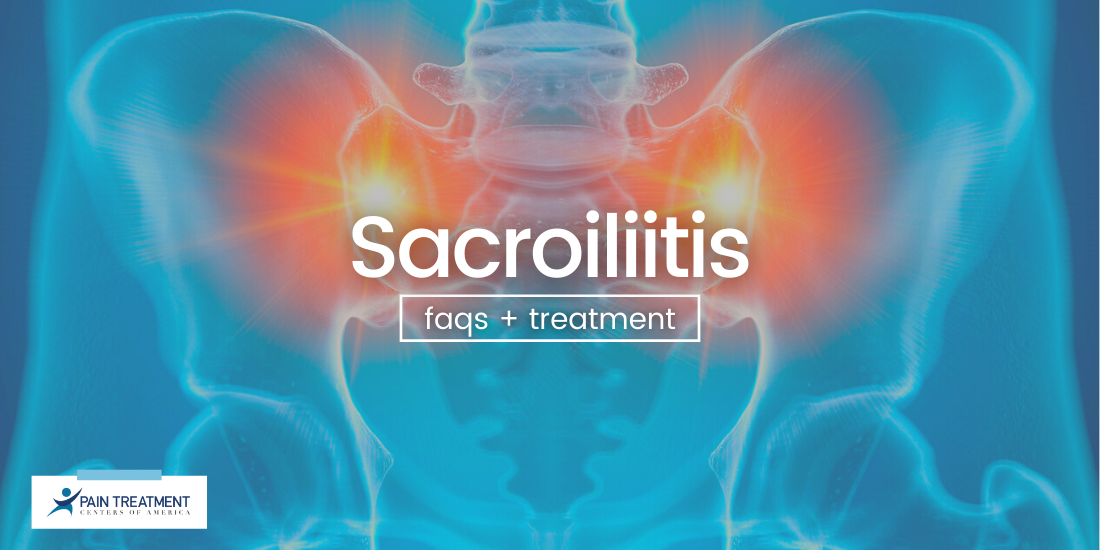
Sacroiliitis: Frequently Asked Questions + Treatment Info
Low back pain is one of the most commonly reported medical issues. For many patients, pain in the lower back persists despite treatment and ongoing preventative measures. As a result, low back pain accounts for billions of dollars spent on healthcare in the United States each year1.
The causes of chronic and acute low back pain are widely varied. Herniated discs, muscle strain, congenital conditions, and underlying mechanical issues of the spine are just a few of the sources of this pain.
Sacroiliitis, an
inflammatory condition of the sacroiliac joints, is estimated to effect between 10 and 25 percent of people who suffer from low back pain2. This condition is often underdiagnosed because the symptoms it causes are mirrored by numerous other back issues.
Despite sacroiliitis being a fairly common condition, many patients have limited knowledge of what it is, its symptoms and its treatment options.
Today, we’re answering some frequently asked questions about sacroiliitis and how it can be managed.
What is Sacroiliitis?
Sacroiliitis, also known as sacroiliac joint dysfunction, refers to inflammation in one or both of the sacroiliac joints (SI joints). The SI joints link the pelvis (the ilium) to the lower spine (sacrum) and are essential for transferring weight between the lower extremities and the spine.
Sacroiliitis is a type of
spondyloarthropathy, a group of inflammatory spinal conditions. Sacroiliitis is typically the first manifestation of a condition known as
axial spondyloarthritis3. It is also the first symptom of ankylosing spondylitis.
What Are the Symptoms of Sacroiliitis?
Sacroiliitis causes SI joint pain. This pain can manifest in a number of ways:
- Pain in the lower back, hips, buttocks and upper thighs
- Pain that intensifies after sitting or standing for a long time
- Pain that intensifies at night
- Stiffness when waking up
- Pain that intensifies after unevenly distributing weight to one foot over the other
- Pain after climbing stairs or intense exercise, like running
Because these symptoms are hallmarks of various mechanical issues of the spine, sacroiliitis is often misdiagnosed, especially in young people.
What Causes Sacroiliitis?
Inflammation of the sacroiliac joints is often an early symptom of an underlying inflammatory condition.
Degenerative arthritis, the breakdown of cartilage due to wear and tear or injury, can occur in the SI joints. Sacroiliitis is one of the first symptoms of degenerative arthritis in the sacroiliac joints.
Psorioatic arthritis is a form of inflammatory arthritis that occurs in people who suffer from psoriasis. Pain and inflammation in the SI joints is often one of the first symptoms of PsA in people with psoriasis. Between 34% and 78% of patients with psoriatic arthritis experience sacroiliitis4.
Ankylosing spondylitis is an inflammatory condition of the spine that can cause fusion of the small bones in the spine. It is a form of arthritis. Sacroiliitis is often one of the first symptoms of ankylosing spondylitis.
Lupus, also known as systemic lupus erythematosus, is an autoimmune disease that causes inflammation in various organ systems, including the joints. SI joint pain is common in individuals with SLE.
Many people without underlying arthritis or autoimmune conditions experience sacroiliitis.
Trauma to the SI joints, injury, pregnancy, and surgery can cause sacroiliitis.
How Is Sacroiliitis Diagnosed?
The first diagnostic measure for sacroiliitis is a physical exam. During the exam, your doctor will press on (palpate) different areas of the hips and buttocks to find specific points of pain. He or she will also use tests of physical movement that engage the SI joints. The pelvic rock test, FABERE and Gaenslen maneuvers are three provocation tests used to induce SI joint pain in the diagnosis of sacroiliitis.
X-rays and MRI may be used in sacroiliitis diagnosis if underlying conditions like ankylosing spondylitis are suspected.
Diagnostic anesthetic injections are also used to pinpoint the source of a patient’s lower back pain. If anesthetic injections into the sacroiliac joint provide pain relief, the SI joints are likely the cause of a patient’s painful symptoms.
Treatment Options for Sacroiliitis
Treatment for sacroiliitis is determined by the underlying causes of the condition, as well as the severity of the patient’s symptoms.
Fortunately, there are many nonsurgical treatments that can provide relief for sacroiliitis symptoms.
Pain relievers,
like over-the-counter pain medications such as NSAIDs (non-steroidal anti-inflammatory drugs) or acetaminophen, can provide pain relief for mild to moderate sacroiliitis pain.
For moderate to severe sacroiliitis pain,
prescription pain relievers and muscle relaxers like Amrix can help provide relief and reduce muscle spasms associated with sacroiliitis.
For patients with a diagnosis of ankylosing spondylitis,
TNFis (tumor necrosis factor inhibitors) can help slow the progression of SI joint damage and provide pain relief5.
Physical therapy can help individuals with sacroiliitis maintain range of motion in their SI joints and provide strengthening exercises for surrounding muscles.
Sacroiliac joint injections are
a minimally invasive treatment method for sacroiliitis pain. These injections are performed by a pain doctor in a clinical setting, and use a combination of steroids and local anesthetics to target one or both of the sacroiliac injections. The procedure typically takes only 30 minutes to complete and begins to take effect in 3-5 days.
Electrical stimulation, also known as transcutaneous electrical nerve stimulation, can help with sacroiliitis pain by blocking the electrical signals involved in SI joint pain.
For particularly severe cases of sacroiliitis that have not responded to other treatment methods,
SI joint fusion is an option.
This procedure uses bone grafts or other instruments to induce bone growth over the SI joints, creating a single immobile unit of the sacrum and ilium.
Treatment for Sacroiliitis at Pain Treatment Centers of America
Pain Treatment Centers of America specializes in pain caused by SI joint inflammation and dysfunction. We offer a variety of treatments that address sacroiliitis pain, help patients return to mobility and recover their quality of life.
PTCOA has
10 clinic locations across the state of Arkansas, as well as 6 interventional surgery centers.
Contact us at
(844) 215-0731 to schedule your appointment or to learn more about our treatment specialties.
Sources:
- "US Spending on Personal Health Care and Public Health ...." 27 Dec. 2016, https://jamanetwork.com/journals/jama/fullarticle/2594716.
- "Sacroiliitis - Cleveland Clinic." https://my.clevelandclinic.org/health/diseases/17736-sacroiliitis.
- "Sacroiliitis – early diagnosis is key - NCBI - NIH." https://www.ncbi.nlm.nih.gov/pmc/articles/PMC6136407/.
- "Sacroiliac joint pain as an important element of psoriatic ...." 12 Apr. 2013, https://www.ncbi.nlm.nih.gov/pmc/articles/PMC3834688/.
- "Do TNF Inhibitors Change the Progression of Sacroiliitis ...." 28 Sep. 2016, https://acrabstracts.org/abstract/do-tnf-inhibitors-change-the-progression-of-sacroiliitis/













